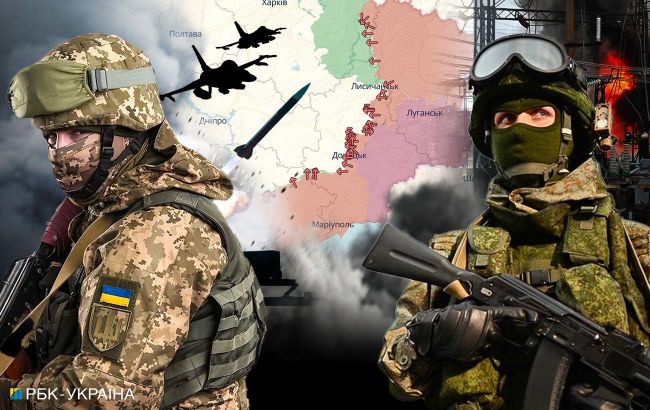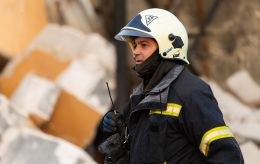Russia-Ukraine frontline overview: What to expect by year-end
 Russia may continue its offensive in the second half of 2024 (collage: RBC-Ukraine)
Russia may continue its offensive in the second half of 2024 (collage: RBC-Ukraine)
Russia is conducting offensives on more than a dozen frontlines. It is likely to concentrate its efforts on several of them, while simultaneously shelling non-frontline regions of Ukraine. Read more about how the war will wage in the second half of 2024 in RBC-Ukraine's article.
Contents
- The biggest threat at the front now
- Ukraine's difficulties
- What to expect next in Russia-Ukraine war
Russia's offensive campaign has continued without any operational pauses for the tenth month in a row. The enemy is now resorting to the tactics of multiple cuts. This was evident in the north of Kharkiv region, near Toretsk, and is now being manifested on a larger scale beyond the front line.
Russia's recent air attacks have shown that it is more organized and innovative in planning new strikes, which can inflict not only physical damage but also psychological impact.
The peak of the critical situation that unfolded for the Ukrainian Defense Forces in the spring has now passed, but the pendulum has not yet swung in Ukraine's direction. Russia still has the strategic initiative, and Ukraine is still trying to stop its movement.
The biggest threat at the front now
Russia is trying to advance with varying success on more than a dozen frontline directions with a length of 980 kilometers of active combat line. The most difficult battles are taking place in the Pokrovsk direction. In five months, the Russians have managed to advance almost 20 kilometers along the railroad from Avdiivka to Novooleksandrivka. And at the same time, seizing the moment, they began to expand their penetration on the flanks.
Now they are separated by one village - Vozdvyzhenka - from the Kostiantynivka - Pokrovsk road (T0504). It plays an important role in supplying Ukrainian units defending the Donetsk region. In the same area, the Russians are trying to reach the Vovcha River (the river of the same name flows near Vovchansk in Kharkiv region) on the border between Prohres and Yasnobrodivka.
Two other threatening areas are in the Kharkiv region. In the east of the region, the Russians are trying to reach the Oskil River from Kupiansk to Borova with a broad front. In one of the sections of this bridgehead - near the village of Pishchane - the Russian occupiers managed to get to the river for a distance of about 11 kilometers.
 Ukrainian military managed to stabilize the situation in the north of Kharkiv region (photo: Facebook, General Staff of the Armed Forces of Ukraine)
Ukrainian military managed to stabilize the situation in the north of Kharkiv region (photo: Facebook, General Staff of the Armed Forces of Ukraine)
Although the Ukrainian Defense Forces have stabilized the situation in the north of the Kharkiv region and stopped Russian troops within Vovchansk and on the Hlyboke-Lukiantsi border, they are not going to make a goodwill gesture there.
By opening a new front, the Russian occupiers had two goals. The main one, according to the RBC-Ukraine's sources in the General Staff of the Armed Forces of Ukraine, is to create a so-called buffer zone near the border. The second was to shackle Ukraine's reserves and stretch Ukraine's forces. This is the tactic of numerous cuts, which forces the Ukrainian command to extinguish widespread fires and prevents it from concentrating on other threatening areas.
After Kharkiv, this was repeated in the Toretsk area, where the front line has not moved since 2014. Russia's immediate goal here is to capture the village of New York, where fighting is already underway, and to reach the Druzhba-Pivnichne-Zalizne line. In the first section, the Russians have penetrated four kilometers in-depth in 10 days, and in the second section - since June 17 - up to 3 kilometers.
To the north, in the Kramatorsk sector, the Russian troops have been trying to capture Chasiv Yar for several months. As of now, they have managed to occupy only the eastern neighborhood of this city - Kanal. The immediate goal of the Russians here is to cross the Siverskyi Donets-Donbas canal, which runs from north to south, either within Chasiv Yar or at least on its outskirts. There is no confirmed evidence that they have already succeeded. This, after all, mainly hinders their advance further into the city.
In other areas - Lyman, Siversk, Kurakhove, Vremivka, and Orikhiv - there are also battles, but the situation looks more controlled and the contact line more static.
Ukraine's difficulties
After the critical months in the spring, the Ukrainian Defense Forces are still focused on stopping the Russians along the entire front. Several factors prevent Ukrainian troops from doing so. The first is technical. The acute shortage of artillery ammunition that the Ukrainian military faced has been partially leveled.
 The gap in shots fired between Ukraine and Russia has almost halved (photo: RBC-Ukraine, Vitalii Nosach)
The gap in shots fired between Ukraine and Russia has almost halved (photo: RBC-Ukraine, Vitalii Nosach)
According to the RBC-Ukraine's sources in the General Staff of the Armed Forces of Ukraine, the Russian advantage in shots has now decreased from 7:1 to 3:1. This was due to both a reduction in Russian shells and an increase in Ukraine's. It is not known exactly how much Ukraine produces and how much it receives from its partners. Russia, according to the RBC-Ukraine's sources in the Ukrainian Defense Forces, produces at least 2.4 million artillery shells a year. This is significantly more than the United States and European countries produce. The quantitative gap in ammunition can be reduced by improving the quality of the ammunition - using more accurate and efficient artillery systems, as well as FPV drones.
UAVs of various types generally play no less important role on the front line, with their help the entire frontline can be viewed and fired upon in both directions for tens of kilometers. The developments that both Ukraine and Russia are considering in the field of drones are similar to a race. In this sense, Ukraine is not far behind Russia. However, Russia's high situational awareness prevents us from deploying long-range air defense systems such as Patriot near the front line, which would allow us to combat an even bigger problem for Ukrainian troops - guided aerial and glider bombs. Scarce systems can become a very easy target for the Russian forces.
Guided and gliding bombs allowed Russians to destroy an object or position in one strike, which would take several days to break through with artillery. The Russians have large stockpiles of old Soviet bombs in their warehouses, and making them guided does not require any extraordinary efforts or innovative solutions.
The only realistic way to reduce the impact of the guided aerial bombs is to defeat their carriers, Russian bombers, and fighters. In this sense, F-16s with appropriate weapons with a range of at least 180 kilometers should be useful for Ukraine. These aircraft, in an as-yet unknown quantity, are to be delivered to Ukraine this summer.
The second factor is organization. Blurred responsibility and competence for the construction of fortifications have repeatedly led to the fact that in some places there were no defense lines.
Several soldiers who spoke to RBC-Ukraine on condition of anonymity claimed that after the retreat from Avdiivka towards Ocheretyne, the defensive lines were not properly prepared. It turns out that the units that were supposed to retreat, for example, from the first line to the second line, simply walked for kilometers in the middle of nowhere. And the Russians follow, relatively speaking, in an open field.
In the Ukrainian Armed Forces, depending on their proximity to the front line, the engineering units of the Armed Forces Support Forces, the engineering units of brigades, the State Special Transport Service, the State Agency for Reconstruction, the Regional Military Administrations, and civilian contractors are responsible for the defense lines. Unfortunately, thanks to coercion and an autocratic apparatus, Russia is much better at solving this issue: both the military and the mass of private builders that the Kremlin has recruited follow a single master plan for building defense. The Surovikin Line was so named because he was the one who supervised its construction and would be the one to be blamed for its unreliability.
However, defense is not just a system of borders, positions, and engineering barriers. It also includes firepower and landmines. The first thing that slowed down the offensive of Ukrainian troops last year in the South was the widespread mining of the Ukrainian territory by the Russians, starting from the supply line. One of the informed military officers told RBC-Ukraine that since the beginning of the great war, the Russians have already used about 8 million mines, which is many times more than Ukraine.
 With the help of UAVs, the situation awareness at the front is very high on both warring sides (photo: GettyImages)
With the help of UAVs, the situation awareness at the front is very high on both warring sides (photo: GettyImages)
Defense lines are also combat orders that people maintain. No trenches, dragon teeth, or ditches will stop Russian troops if there are no Ukrainian troops in that position. The shortage of personnel at the front should have been solved by the adopted laws on mobilization. Politicians claim that recruitment to combat units has picked up since the new rules were enacted. However, military interlocutors say that the problem of understaffing on the front line remains: instead of sending recruits to replenish existing brigades, they are being used to form entirely new ones. This solution does not suit all the military with whom RBC-Ukraine spoke. Russia is well aware of the problem of understaffing in Ukrainian troops, which is why it inflicts these cuts, which is a very dangerous trend.
The human factor also manifests itself at another level. Over the past six months, RBC-Ukraine has heard about at least three cases of unauthorized withdrawal of our units from their positions without informing the units defending in the neighborhood. As a result, Russia managed to break through in depth in certain areas. And this problem, unlike the others listed above, can only be solved by ourselves.
What to expect next in Russia-Ukraine war
Informed interlocutors in several military bodies believe that in the second half of this year, Russia will put more or less intense pressure on all currently active frontlines. However, efforts will be concentrated on a few of them, primarily in the Donetsk region.
If the T0504 highway is cut, Russia will be able to move to both Pokrovsk and Kostiantynivka. Informed sources in the Ukrainian Defense Forces believe that Russia will choose the first option. And the Pokrovsk direction will remain one of the main ones for the Russians in the second half of this year.
Another priority area for Russia will be the Toretsk area, given that it has recently managed to achieve unexpectedly significant success there. The third area Russia will focus on is Kramatorsk and the town of Chasiv Yar.
"Russia is now able to regroup forces very quickly. Since all these directions are close to each other, the Russians can alternately engage in one of them, depending on where the conditions are more favorable for them. However this does not exclude that Russians can juggle forces in this way in other areas to distract Ukrainian troops or if they see gaps in Ukrainian defense," says one of the RBC-Ukraine's high-ranking sources in the Ukrainian Defense Forces.
At the same time, another source in Ukraine's General Staff believes that Russia will also focus on the north of the Kharkiv region, as the Russian forces have not fulfilled Putin's task there.
"Putin set a task to create a buffer zone. And this was indeed their primary goal. He wanted to show the population of Belgorod, Kursk, and Bryansk regions that he could protect them because the fact that raids, shelling, and so on are periodically taking place there directly affects his reputation inside. To create a buffer zone, they need to move at least 20-30 kilometers into the border area, a task that has not been realized yet," the source says.
 By the end of the year, the Ukrainian Defense Forces have a good chance of stabilizing the front (photo: GettyImages)
By the end of the year, the Ukrainian Defense Forces have a good chance of stabilizing the front (photo: GettyImages)
It is for this reason that Moscow has decided to postpone the idea of an offensive in another part of our border, in the Sumy region. Several interlocutors say that the situation there remains tense, but no offensive groups have been spotted there yet.
At the same time, at the end of the year, after the likely change of administration in the United States, talks about the need for a truce and a cessation of active hostilities will intensify in the international arena. How this will ultimately turn out will largely depend on the situation of both sides in the war.
Another risk for the second half of this year is air attacks from Russia. After the Russian massive attacks on the Ukrainian energy sector in the spring, Russia has switched to targeted attacks, but more sophisticated and planned. They are experimenting with radio communications, changing the combat airfields where they equip their planes with missiles. Russia is also carefully studying the routes it uses to send missiles to pass through the gaps that exist between Ukrainian air defense systems.
Now, according to the RBC-Ukraine's interlocutors, the main targets of Moscow are Ukrainian airfields, defense industry enterprises, and in some places, the energy sector. And several of RBC-Ukraine's interlocutors fear that in the fall Russia may again intensify strikes on the Ukrainian energy system, waiting for Ukraine to repair some of what has been destroyed. The effectiveness of Russia's plan will depend on whether Ukrainian partners fulfill their promises to strengthen Ukraine's air defense.
As for the overall development of events, the average and most likely scenario looks like this. By the end of the year, the Russians will gradually make inroads into Ukrainian defense at the front, but these will be tactical gains. Moscow has adapted the recruitment process so that it has a constant flow of recruits, and this allows it to replenish its losses on the front line. Because of this, the Russian occupiers are still able to fight without operational pauses.
The volume of this recruitment, on the one hand, allows the Kremlin not to provoke popular anger through a larger-scale forced mobilization, but at the cost of more modest and gradual advances. However, there are no prerequisites for larger-scale Russian breakthroughs. The risk that he will be able to capture the entire Donetsk region by the end of the year is also low.
Instead, by the end of the year, the Ukrainian Defense Forces have a good chance of stopping Russia's movement and stabilizing the front, according to several sources in military circles. However, it is not yet possible to talk about moving to the next stage - counteroffensive actions - at the end of this year or early next year. However, the best option is if the Ukrainian offensive operation is a surprise for the vast majority of Ukrainians and the Western community, and only a very limited number of people know about its planning and launch.

